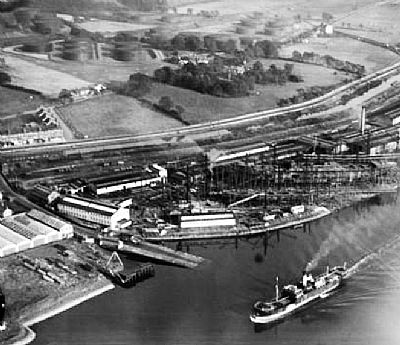NAPIER AND MILLER SHIPYARD, Old Kilpatrick.
If you look for remnants of this shipyard today, you will also be looking at those of the Erskine Ferry. The slipway and stonework of that later development evolved out of the shipyard. Above you now looms the Erskine Bridge, long since making the ferry irrelevant. And on the spot of the shipyard sheds, we now find a recyling depot. A rather ignominious end for a once important industry.
According to Grace's Guide To British Industrial History.
The firm made over 120 ships before going out of business due to the Depression.
1898 Napier and Miller Limited was registered, with a capital of £30,000, to carry on the business of shipbuilding, ship-repairing, and engineering. It took over the yard in Yoker that had previously been owned by Napier, Shanks and Bell. Henry M. Napier was managing director.
1906 The company moved to a new five berth site at Old Kilpatrick as their land was acquired by the Clyde Navigation Trust to build a new dock. This new site was well designed and also had sufficient surrounding space to allow for expansion should it be required. Work began on the first ship this year, Irish Monarch, followed by steam tramps and the last two barques built in Britain for home ownership.
WWI The yard made sloops, minesweepers and aircraft along with merchant ships. The yard also continued making standard vessels such as an "AO" tanker and "A" types.
Wikipedia adds : It also assembled a number of Royal Aircraft Factory B.E.2 aircraft.In the 1920s the company built passenger ships and Great Lakes traders for United States, Canadian and Norwegian companies. The company also did contract work for other shipbuilders, for example being subcontracted by A. & J. Inglis to build the hull for the paddle steamer PS Eagle III for Buchanan Steamers.
Also see : ERSKINE FERRY for photos of the remaining slipway etc : index.asp?pageid=718426 ; THE SALTINGS : index.asp?pageid=715957 ; WEE CHATTY CAFE : index.asp?pageid=737533

In this aerial view we can see the slipway that still exists and make out some of the stonework of the Clyde embankment. If you look closely, you can also make out the almost parallel lines of Dumbarton Road, the Forth and Clyde Canal and the railway. Note that this latter was between the canal and the Clyde then. You can make out its route when walking around the Saltings. © Canmore
CANMORE : Photo entitled "Napier and Miller shipyards, Old Kilpatrick. Oblique aerial photograph taken facing east". SC 1246259. ©. Used with permission and acknowledgement. https://canmore.org.uk/collection/1246259
GRACE'S GUIDE TO BRITISH INDUSTRIAL HISTORY : https://www.gracesguide.co.uk/Napier_and_Miller
WIKIPEDIA : https://en.wikipedia.org/wiki/Napier_and_Miller

